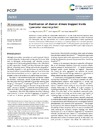Identificador persistente para citar o vincular este elemento:
https://accedacris.ulpgc.es/jspui/handle/10553/74701
| Campo DC | Valor | idioma |
|---|---|---|
| dc.contributor.author | Azofra Mesa, Luis Miguel | en_US |
| dc.contributor.author | Elguero, José | en_US |
| dc.contributor.author | Alkorta, Ibon | en_US |
| dc.date.accessioned | 2020-10-13T12:46:10Z | - |
| dc.date.available | 2020-10-13T12:46:10Z | - |
| dc.date.issued | 2020 | en_US |
| dc.identifier.issn | 1463-9076 | en_US |
| dc.identifier.other | Scopus | - |
| dc.identifier.uri | https://accedacris.ulpgc.es/handle/10553/74701 | - |
| dc.description.abstract | Interanionic H-bonds (IAHBs) are unfavourable interactions in the gas phase becoming favoured when anions are in solution. Dianion dimers are also susceptible to being trapped inside the cavities of cyanostar (CS) macrocycles, and thus, the formation of 2 : 2 anion : cyanostar aggregates is mainly supported by three kinds of interactions: IAHBs between the dianions, π-π stacking between the confronted cyanostars, and the presence of an intricate network of multiple C(sp2)HO H-bonds between cyanostar ligands and the anionic moieties. An analysis of the interaction energies supported by NBO reveals a slight cooperative effect of the CSs on the IAHB stabilisation. | en_US |
| dc.language | eng | en_US |
| dc.relation.ispartof | Physical Chemistry Chemical Physics | en_US |
| dc.source | Physical Chemistry Chemical Physics [EISSN 1463-9084], v. 22 (20), p. 11348-11353, (Mayo 2020) | en_US |
| dc.subject | 2307 Química física | en_US |
| dc.title | Stabilisation of dianion dimers trapped inside cyanostar macrocycles | en_US |
| dc.type | info:eu-repo/semantics/Article | en_US |
| dc.type | Article | en_US |
| dc.identifier.doi | 10.1039/D0CP01321H | en_US |
| dc.identifier.scopus | 85085536137 | - |
| dc.contributor.authorscopusid | 55142490200 | - |
| dc.contributor.authorscopusid | 35474081900 | - |
| dc.contributor.authorscopusid | 7005819296 | - |
| dc.identifier.eissn | 1463-9084 | - |
| dc.description.lastpage | 11353 | en_US |
| dc.identifier.issue | 20 | - |
| dc.description.firstpage | 11348 | en_US |
| dc.relation.volume | 22 | en_US |
| dc.investigacion | Ciencias | - |
| dc.type2 | Artículo | en_US |
| dc.description.numberofpages | 6 | en_US |
| dc.utils.revision | Sí | - |
| dc.date.coverdate | Mayo 2020 | en_US |
| dc.identifier.ulpgc | Sí | - |
| dc.contributor.buulpgc | BU-BAS | en_US |
| dc.description.sjr | 1,053 | |
| dc.description.jcr | 3,676 | |
| dc.description.sjrq | Q1 | |
| dc.description.jcrq | Q1 | |
| dc.description.scie | SCIE | |
| item.grantfulltext | open | - |
| item.fulltext | Con texto completo | - |
| crisitem.author.dept | GIR IUNAT: Fotocatálisis y espectroscopía para aplicaciones medioambientales. | - |
| crisitem.author.dept | IU de Estudios Ambientales y Recursos Naturales | - |
| crisitem.author.orcid | 0000-0003-4974-1670 | - |
| crisitem.author.parentorg | IU de Estudios Ambientales y Recursos Naturales | - |
| crisitem.author.fullName | Azofra Mesa, Luis Miguel | - |
| Colección: | Artículos | |
Citas SCOPUSTM
19
actualizado el 08-jun-2025
Citas de WEB OF SCIENCETM
Citations
20
actualizado el 08-jun-2025
Visitas
135
actualizado el 12-jul-2025
Descargas
249
actualizado el 12-jul-2025
Google ScholarTM
Verifica
Altmetric
Comparte
Exporta metadatos
Los elementos en ULPGC accedaCRIS están protegidos por derechos de autor con todos los derechos reservados, a menos que se indique lo contrario.
